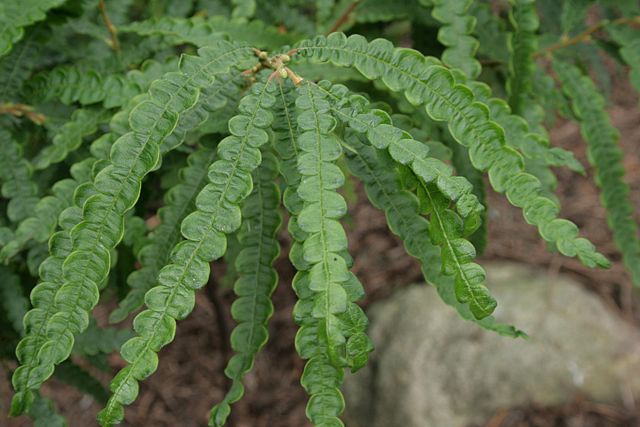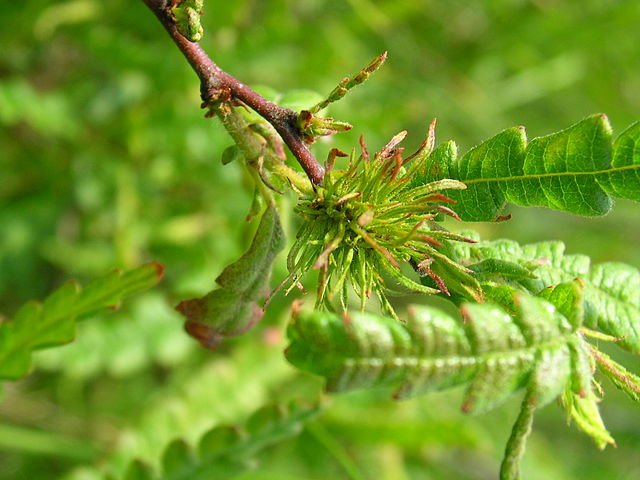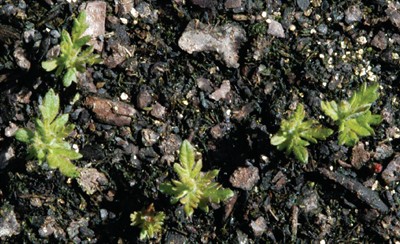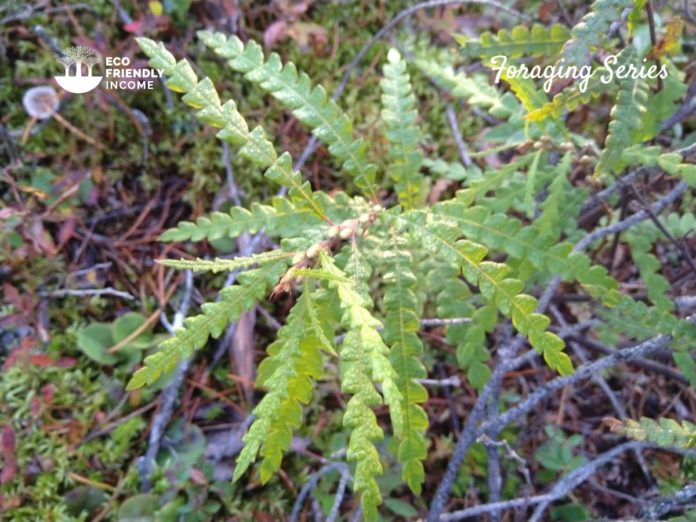It’s one of those fragrant wild plants you’ve probably smelt so many times without knowing. They’re pretty common once you’re in the boreal forest, and luckily, identifying sweetfern (Comptonia peregrina) is pretty easy.
On hot summer days, you can smell its sweet fragrance carried through the wind.
Sweetfern’s pleasant aroma can be used to make perfume, soap, or even candles. Mmmm.
As a tree planter working in eastern Canada, I’ve seen this plant countless times. In some places, I know it’s there without even seeing it because of the smell.
Sweetfern is a unique plant, it’s the last extant species of the genus Comptonia. Sadly, all other species of this genus are now extinct today.
Because of this, I try to be very thoughtful when harvesting it. When I forage for this herb, I only pick it sustainably, and I think everyone also should.
If you go out picking all the sweetfern near you, they might one day become extinct too.
A great thing you can do is to bring some home and propagate them yourself.
I hope to help anyone looking to do this and help us repopulate this native plant.
Here’s what you can expect to learn in this article:
- Sweetfern Picking Season
- How to Identify Sweetfern
- Where You Can Find it
- How to Harvest it Sustainably
- How to Use & Store it
- How to Propagate Sweetfern
Let’s get started!
Sweetfern Picking Season
Sweetfern leaves can be picked any time during summer but the best time to get potent leaves is early summer.

You can also collect their nuts mid-summer. They spawn under mini spike balls similar to chestnuts.
How to Identify Sweetfern (Comptonia Peregrina)



Sweetfern is a deciduous shrub from North America that likes to masquerade as a fern. But despite its name, it’s not a fern!
It actually belongs to the same family as wax myrtle or bayberry, which are berry-producing deciduous shrubs.
Sweetfern, unlike its cousins, doesn’t produce berries. Instead, they produce nuts that develop in spiked burrs along the branches.
Also, in early spring, the first thing to appear on their bare branches are catkins.
Sweetfern leaves are elliptical, with lobate to crenate margins, and grow in an alternate arrangement, and pinnatifid structure.
When you find wild sweetfern, chances are you’ll find them growing in dense colonies.
The plants have multiple stems with loose, spreading branches. Their leaves are an olive green color during summer and turn into a copper brown color in the fall.
Their strong, sweet aroma is a distinctive way to identify them.
Where You Can Find Wild Sweetfern
You can find Sweetfern growing in groves within coniferous forests. They usually grow in well-drained, dry, acid, sandy, or gravelly soils.
It’s a native plant to eastern North America, from Quebec, and Nova Scotia to as south as Northern Georgia. Here’s a map of where they grow: USDA PLANTS MAP.
I’ve often seen them grow in sandy patches of forest under Jackpine trees, and on beachsides near freshwater lakes.
Sweetfern (Comptonia peregrina) likes to grow near the following plants:
- Red Clover (Trifolium pratense)
- White Pine (Pinus strobus) & Jack Pine (Pinus banksiana)
- Kalmia (Kalmia Angustifolia)
When you see any of these, there’s a good chance sweetfern is also growing somewhere close.
How to Harvest Sweetfern Plants Sustainably
Since this plant is the last remainding species of its genus, you want to be very thoughtful of each shrub when you harvest.
My personal method for picking sweetfern sustainably:
- Pick a plant that has enough neighbors (leave the single plants alone)
- Use a sickle or pinch with your fingers the 5-6 bottom leaves from a plant
- Move on to the next plant
It’s simple, taking the bottom leaves will minimally harm the plant, and it’ll keep growing.
If you want to harvest new year growths, take the caps off from a few plants per colony and move over to a new colony.
How to Use & Store Freshly Picked Sweetfern Leaves
Sweetfern Uses & Medicinal Properties
Sweetfern is very rich in antioxidants, which give it great properties as an anti-inflammatory herb.
Native Americans often used sweetfern leaves, roots, fruit, and bark to make tea. Comptonia peregrina tea is known to boost energy, to treat colds, urinary tract, and intestine infections.
The Ojibwe peoples also used sweetfern to line and cover their baskets when picking berries to help preserve them.
Their seasonal nuts can also be roasted and added to salads
How to Dry & Store Them
To retain the top flavor and fragrance, sweetfern leaves need to be dried and stored properly.
First, you want to air dry them. What I do is use a mesh bag when I collect leaves, then when I’m done I hang up the mesh bag.
You don’t want to hang the mesh bag directly in the sun, or it risks breaking apart the inner components and oils of the leaves.
Let them air dry for a week.
Finally, place them in a sealed mason jar, stored away in a cool dark place.
When you feel like tea, just add 4-5 leaves to a cup and let them steep for 5 mins in hot water. You’ll get to smell and taste the delightful aroma again!
How to Propagate Sweetfern Plants (Comptonia peregrina)

Hardiness Zone: 2-5

Soil Type: Well-drained, acidic, nutrient-poor, sand, clay, or peat moss.

Water: Normal. Fair Drought Resistance.

Exposure: Full Sun
Sweetfern (Comptonia peregrina) is an deciduous shrub hardy up to zone 2. A sweetfern shrub should be planted in well-drained, acidic, sandy, peat moss or clayey soils. You should water it weekly to make sure it retains moisture, especially when they’re producing their nuts.
Commercial Value
Propagating Sweetfern is not an easy task, but it has much value commercially and environmentally. The leaves have fragrant flavor and hold medicinal properties which make them a popular tea.
Additionally, it’s a sturdy native plant that can grow in hard-to-adapt environments. They make great landscaping shrubs at home or on commercial properties city-wide.
Their rhizomous nature also makes them great erosion-fighting plants.
Growing and propagating sweetfern is possible if you have the right environment. Let me show you how:
The Best Way to Propagate Sweetfern Plants:
Division
Sweetfern can be propagated by root crown division and by dividing the rhizomes.
The best time to take sweetfern rhizome cuttings is late Fall when the plant is dormant.

Crown Division
- Find a wild sweetfern patch and identify the largest plant.
- Try to pull the plant out, if there’s resistance, look at where the roots go and try to dig them out.
- Once you have the plant out, you can split the root crown by hand or with a sharp knife from top to bottom.
- Make sure both sides have enough roots before you divide.
- Now take a good look at your divided plants, remove any dead or diseased foliage.
- Repot the two individually and water thoroughly until they are established.
Dividing the Rhizomes
Dividing the rhizomes successfully will require two steps: Digging out & Stratifying
- Find a large plant and inspect its surrounding roots.
- Some roots will go horizontally and new shoots come out further down, those are the rhizomes.
- Use a digging spade to dig 3-4 inches down to find the rhizomes.
- Lift a rhizome strand out of the ground, and cut into 2 inch pieces.
- Store the cuttings in a moist plastic bag for transport.
Rhizomes taken at this time of year will need to go through stratification to successfully sprout.
- At home, get some pots ready for the winter dormancy. For fuller plants, you want at least 2 cuttings per pot.
- Fill your pots with horticultural grade vermuculite, or alternatively metro mix 510 growing medium.
- Water them thoroughly and then place them in a cooler or minimally heated hoop house.
- Let them rest for 2-3 months, going through a cool period like this will help break dormancy once spring arrives.
When your sweetfern cuttings have gone through this stratification period, you can now take them out in warm spring weather or bring them into a warm greenhouse.
Within one to two weeks small shoots should start to appear in your pots or propagation beds.

From there, within six weeks, the sweetfern rhizome cuttings should have developed into strong liners. These plants themselves can be a great source of rhizomes in the future.
Any other plant that’s grown to be sold commercially should be transplanted into 1 to 2-gallon pots. Within a year they’ll grow large enough to be sold in stores.
Liner Soil & Fertilizer
For this stage of the plant, a different type of soil is required:
4:2:1 aged pine bark/sphagnum peat moss/sand blend seems to do quite well.
As for the fertilizer, apply 20-10-20 liquid fertilizer at 200 ppm to your 2-inch pot liners once a week.
Conclusion
If you live in Eastern North America and sweetfern is a native plant to your area, I highly recommend using it as a landscaping plant.
Truth is, many of the landscaping plants we buy at garden centers end up being invasive. This means they spread to forests and compete with the native plants.
This can lead to some species getting completely wiped out in areas.
This is why I encouage people to plant and propagate sweetfern in their area if it’s a native plant.
I hope I covered everything you need in this guide to serve that very purpose.
Let’s get propagating!

